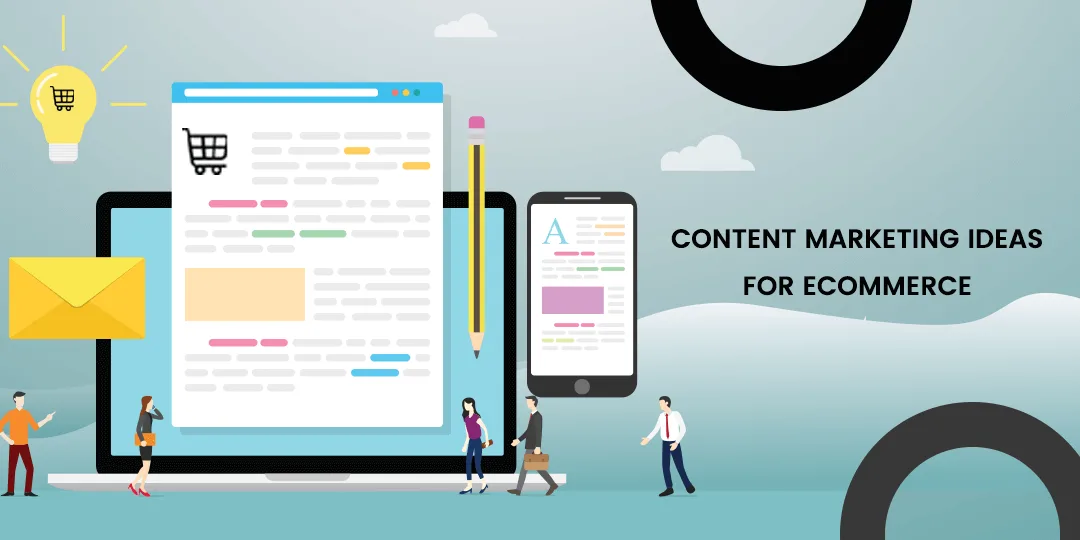Hello Readers,
Recently we have shared 7 sales Techniques You can’t Miss to Boost Ecommerce sales,
Today We have bring the best modern content marketing ideas for eCommerce. Let’s dip into it,
According to the search engine giant, Google, hundreds of online users search for information about eCommerce marketing ideas each month. While the numbers are impressive, users don’t get that much information about marketing ideas. This is unfortunate, especially for small business owners who are keeping their eye out for tips and tricks that will help them grow their business. This article aims to help entrepreneurs by listing content marketing ideas that could help them reach their business goals in this year 2020.
Before we take the plunge, let’s put things into perspective. By doing that, I want you to imagine online marketing as a majestic tree. Yes, it’s not just any tree, it has to be majestic. It’s strong, powerful, and has branches that comprise of email marketing, search engine marketing, social media marketing, and the list goes on. These branches are channels that businesses can take advantage of in order to boost customer awareness. To give you a clearer picture, various content marketing strategies paved the way to having consumers spend a whopping $455 billion online purchases in the year 2018. Impressive, right?
Ecommerce as a Marketing Channel
It was in 1984 when the world came to know eCommerce as a sales channel. Since then, it has grown at a rate of 20% each year. These days, the marketplace is constantly undergoing digitalization. People are using more than one mobile device each day just to accomplish their daily tasks. The same logic applies when it comes to shopping. Sure there are malls out there, but a growing number of people now opt to shop via laptops, watches, desktops, phones, even personal assistant devices like Google Home and Alexa.
Digitalization is a good thing, but it presents a challenge to business owners both big and small. They need to be more strategic when it comes to selling their products. They need to make sure that their products are visible in spaces where consumers spend a huge chunk of their time. This means making products appealing to online audiences. Here are some ways to do that:
Analyze Your Customer Behavior
One of the advantages that eCommerce stores have over physical stores is their ability to keep track of their customers’ behavior. Since this happens in real time, it’s easier for online entrepreneurs to tweak whatever needs to be tweaked when it comes to content marketing. This is made possible because the information you get allows you to customize your content to match the behavior of your customers online. You can decide on what items to sell during a certain period of time, how to sell it, and how to promote it. The task is not at all easy, but the rewards are worth all that hard work.
Social Selling
Some months ago, Facebook introduced a special feature that allows entrepreneurs to upload their product catalog on their business page. This makes it easy for them to share their products without having to worry about flooding their customers with too much information. It’s a classy way of selling through social media. Customers can access more information about the products when they browse through the pages in the product catalog. Since this is happening online, it’s easy for them to make a purchase once they see something they fancy about.
Put a Premium on Customer Reviews
It’s a known fact that word of mouth plays an important role when it comes to making purchases. Most purchases push through after the customer hears reviews or recommendations from past purchasers, friends, and family. This is why there’s value in highlighting customer reviews. The most strategic way to go about this is by putting the reviews just before the customer reaches the point of purchase. It can help give your customers the extra nudge they need when they’re on the fence about buying something from your online store.
Craft Targeted Communications
The transaction doesn’t have to end when a customer adds an item to a cart. You can keep communication lines going by customizing email templates for people who purchased from your online store. By keeping them in the loop, you can easily give updates about promos, sales, and discounts. You can even remind them about items that they forgot to purchase! Make abandoned shopping carts a thing of the past by reminding your customers and convincing them to click that purchase button.
Storytelling
One of the recent and effective options that eCommerce businesses are implementing in their strategies is Storytelling. The process of storytelling leads you to connect to your prospective customers, and also generate the relevant traffic and media shares.
This approach is based on some of the basic things like:
- Understanding your target audience
- Thinking about the audience needs while deciding the products
- How your products or offers can help buyers
- Your brand message and deals
- Make effective use of blogs, graphics presentation templates, and images in the process. Creating infographics in form of stats/ideas will be a great option for your storytelling process.
- How to / FAQ videos will also involve the process.
In storytelling, you have to mention the mission of your business, provide insights, real-life experiences and including your customer testimonials is also an important aspect.
Guest Blog Outreach
guest blogging has now become a way to get around such links by creating engaging, well-researched content, and submit it to guest blogging websites within a specific niche. If your content gets accepted, you’ll be able to promote your business, increase the website’s traffic, boost the linking sites and SEO Service, and thus improve sales.
Final Thoughts
Online shopping is constantly evolving that’s why business owners need to constantly update themselves with the latest trends in content marketing. At the end of the day, the best strategy is still about getting to know your customers so you know how to serve them better. Invite them to ask questions, share recommendations, or talk about their experience while using your product. You can use this information to create content and reach out to more people.





